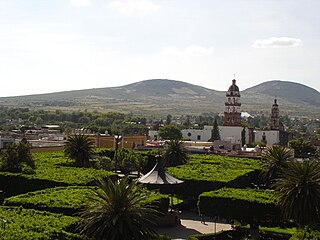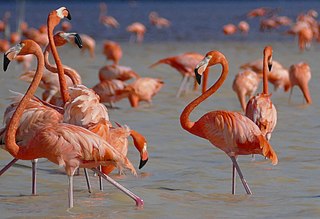
Guanajuato, officially the Free and Sovereign State of Guanajuato, is one of the 32 states that make up the Federal Entities of Mexico. It is divided into 46 municipalities and its capital city is Guanajuato.

Silao, officially Silao de la Victoria, is a city in the west-central part of the state of Guanajuato in Mexico. It is the seat of the municipality with the same name. As of the 2005 census, the city had a population of 66,485, making it the seventh-largest city in the state. Silao is a center of agricultural and industrial activity.

Lake Pátzcuaro is a lake in the municipality of Pátzcuaro, Michoacán, Mexico.

Yuriria, Guanajuato, Mexico,(Spanish: [ɟʝuˈɾiɾja]), is one of 46 municipalities in the Mexican state of Guanajuato.

The Lerma River is Mexico's second longest river. It is a 750 km-long (470 mi) river in west-central Mexico that begins in Mexican Plateau at an altitude over 3,000 metres (9,843 ft) above sea level, and ends where it empties into Lake Chapala, Mexico's largest lake, near Guadalajara, Jalisco. Lake Chapala is the starting point of Río Grande de Santiago, which some treat as a continuation of the Lerma River. In combination, the two are often called the Lerma Santiago River. The Lerma River is notorious for its pollution, but the water quality has demonstrated considerable improvement in recent years due mostly to government environmental programs and through massive upgrading projects of sanitation works.

Lake Cuitzeo is a lake in the central part of Mexico, in the state of Michoacán. It has an area of 300–400 km2 (120–150 sq mi). The lake is astatic, meaning the volume and level of water in the lake fluctuates frequently. It is the second-largest freshwater lake in Mexico.

Salvatierra is a Mexican city located in the valley of Huatzindeo in the lowlands of the state of Guanajuato. It is rich in civil and religious architecture; haciendas, bridges, convents and large houses surrounded in tradition and history. With an area of 507.70 square kilometres, Salvatierra accounts for 1.66% the total area of the state. It is bordered to the north by Tarimoro and Cortazar, to the south by Acámbaro and the state of Michoacán, to the west by Yuriria and Santiago Maravatío, and to the northeast by Jaral del Progreso. The municipality had a total of 94,558 inhabitants of which 34,066 lived in the city of Salvatierra, according to the 2005 census. As of 2020 the municipality had a total of 94,126 inhabitants, compared to 2010, the population in Salvatierra decreased by -3.02%

Uriangato is a city and one of 46 municipalities of Guanajuato, located just north of the border between the states of Guanajuato and Michoacán in west central Mexico. Uriangato city is geographically united with Moroleon city and Yuriria city, these three cities form a metropolitan area. Since October 2010, this metropolitan area is the 75th biggest city of Mexico and the 5th biggest in Guanajuato. It is smallest of the 56 metropolitan areas in Mexico.

The Central Mexican matorral is an ecoregion of the deserts and xeric shrublands biome of central Mexico. It is the southernmost ecoregion of the Nearctic realm.

The Bajío dry forests is a tropical dry broadleaf forest ecoregion in western−central Mexico.

Huandacareo is an archaeological zone located about 60 kilometers north of the city of Morelia, in the state of Michoacán.

Cuitzeo is a municipality located in the north of the Mexican state of Michoacán. The municipal seat is the town of Cuitzeo del Porvenir It is located in a relatively flat depression around Lake Cuitzeo, a large, very shallow lake, which is in danger of disappearing. The town was officially founded in 1550, with the founding of a large Augustinian monastery, which still stands. Today, the town is the seat of a rural municipality, providing local government to surrounding communities.

José Corona Núñez was a Mexican author, anthropologist, and history professor who discovered several important archeological sites throughout México. His main body of work revolved around his native state of Michoacán, and in particular the Tarascan or Purépecha culture.
Federal Highway 43D is a toll highway connecting the cities of Morelia, Michoacán and Salamanca, Guanajuato. It is operated by Autopista Morelia-Salamanca, S.A. de C.V. (CAMSSA), and the toll is 93 pesos to travel its 107.95-kilometre (67.08 mi) length.

The Sinaloan dry forests is a tropical dry broadleaf forest ecoregion in western Mexico. It is the northernmost ecoregion of the Neotropical realm.

The Central Mexican wetlands is a flooded grasslands and savannas ecoregion in central Mexico.

Siete Luminarias is a group of seven extinct volcanoes in central Mexico, located in and around the town of Valle de Santiago in the state of Guanajuato.

Sierra de Lobos is a mountain range in Guanajuato state of central Mexico, The mountains rise north of León. The range is a protected natural area, and provides surface water, groundwater recharge, wildlife habitat, and recreation for the surrounding region.

Ría Celestun Biosphere Reserve is a biosphere reserve in Mexico. It is located on the northwestern Yucatán Peninsula in the states of Yucatán and Campeche. The reserve is home to extensive mangrove wetlands, and rich in birds and other wildlife.
Los Petenes Biosphere Reserve is a biosphere reserve in Mexico. It is located on the western Yucatán Peninsula in the state of Campeche. The reserve is home to extensive mangrove wetlands, and rich in birds and other wildlife.




















